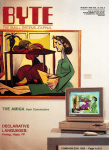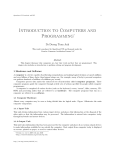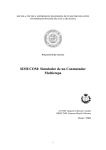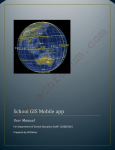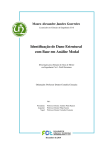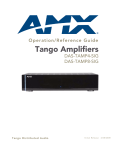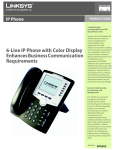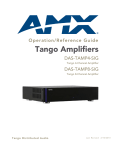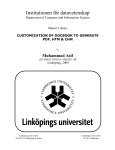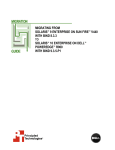Download CBSE Board Syllabus For 2014 Exam
Transcript
14. COMPUTER SCIENCE (Code 083) Learning Objectives: 1. To develop logic for Problem Solving 2. To understand the concept of Object Oriented Methodology 3. To implement Object Oriented Programming using C++ 4. To understand the concept of working with Relational Database 5. To understand the basic concept of Logic of Computing 6. To understand the basic concepts of Communication and Networking technologies 7. To understand Open Source Software Competencies: The student will develop the following proficiency: 1. Identifying Computer Components / Subsystems / Peripherals 2. Problem Solving using Object Oriented Programming 3. Database Handling Class XI (Theory) Duration: 3 hours Unit No. Total Marks: 70 Unit Name Periods Marks Th Pr Tot Th Pr Total 1. COMPUTER FUNDAMENTALS 10 5 15 10 2 12 2. INTRODUCTION TO C++ 25 20 45 14 8 22 3. PROGRAMMING METHODOLOGY 10 10 20 10 2 12 4. PROGRAMMING IN C++ 65 35 100 36 18 54 110 70 180 70 30 100 UNIT 1: COMPUTER FUNDAMENTALS Evolution of computers; Basics of computer system and its operation: Functional Components and their inter-connections; concept of Booting. Software Concepts: Types of Software - System Software, Utility Software and Application Software; System Software: Operating System, Compiler, Interpreter and Assembler; Operating System: Need for operating system, Functions of Operating System (Processor Management, Memory Management, File Management and Device Management), Types of operating system 154 Interactive (GUI based), Real Time and Distributed; Commonly used operating systems: UNIX, LINUX, Windows, Solaris, BOSS (Bharat Operating System Solutions); Mobile OS - Android, Symbian. Illustration and practice of the following tasks using any one of the above Operating Systems: • Opening/Closing Windows • Creating/Moving/Deleting Files/Folders • Renaming Files/Folders • Switching between Tasks Utility Software: Anti Virus, File Management tools, Compression tools and Disk Management tools (Disk Cleanup, Disk Defragmenter, Backup) Application software: Office Tools - Word Processor, Presentation Tool, Spreadsheet Package, Database Management System; Domain specific tools - School Management System, Inventory Management System, Payroll System, Financial Accounting, Hotel Management, Reservation System and Weather Forecasting System Number System: Binary, Octal, Decimal, Hexadecimal and conversion amongst these number systems. Internal Storage encoding of Characters: ASCII, ISCII (Indian scripts Standard Code for Information Interchange), and UNICODE (for multilingual computing) Microprocessor: Basic concepts, Clock speed (MHz, GHz), 16 bit, 32 bit, 64 bit processors, 128 bit processors; Types - CISC Processores (Complex Instruction set computing), RISC Processors (Reduced Instruction set computing), and EPIC (Explicitly parallel Instruction computing). Memory Concepts: Units: Byte, Kilo Byte, Mega Byte, Giga Byte, Tera Byte, Peta Byte, Exa Byte, Zetta Byte, Yotta Byte Primary Memory: Cache, RAM, ROM Secondary Memory: Fixed and Removable Storage - Hard Disk Drive, CD/DVD Drive, Pen Drive, Blue Ray Disk Input Output Ports/Connections: Serial, Parallel and Universal Serial Bus, PS-2 port, Infrared port, Bluetooth, Firewire. Note : Exploring inside computer system in the computer lab class. UNIT 2: INTRODUCTION TO C++ Getting Started : C++ character set, C++ Tokens (Identifiers, Keywords, Constants, Operators), Structure of a C++ Program (include files, main function), Header files - iostream.h, iomanip.h, cout, cin; Use of I/O operators (<< and >>), Use of endl and setw (), Cascading of I/O operators, Error Messages; Use of editor, basic commands of editor, compilation, linking and execution. Data Types, Variables and Constants: Concept of Data types; Built-in Data types: char, int, float and double; Constants: Integer Constants, Character constants - \n, \t, \b), Floating Point Constants, String Constants; Access modifier: const; Variables of built-in data types, Declaration/Initialisation of variables, Assignment statement; Type modifier: signed, unsigned, long 155 Operator and Expressions : Operators: Arithmetic operators (-,+,*,/,%), Unary operator (-), Increment (++) and Decrement (--) Operators, Relation operator (>,>=,<,<=,= =,!=), Logical operators (!, &&,||), Conditional operator: <condition>? <if true>:<if false>; Precedence of Operators; Automatic type conversion in expressions, Type casting; C++ shorthands (+=, -=, *=, /=, %=) UNIT 3: PROGRAMMING METHODOLOGY General Concepts; Modular approach; Clarity and Simplicity of Expressions, Use of proper Names for identifiers, Comments, Indentation; Documentation and Program Maintenance; Running and Debugging programs, Syntax Errors, Run-Time Errors, Logical Errors Problem Solving Methodologies: Understanding of the problem, Identifying minimum number of inputs required for output, Writing code to optimizing execution time and memory storage, step by step solution for the problem, breaking down solution into simple steps, Identification of arithmetic and logical operations required for solution, Control Structure: Conditional control and looping (finite and infinite) UNIT 4: PROGRAMMING IN C++ Flow of control: Conditional statements: if-else, Nested if, switch..case..default, use of conditional operator, Nested switch..case, break statement (to be used in switch..case only); Loops: while, do - while , for and Nested loops Inbuilt Functions Header file Categorization Standard input/output functions Character Functions Header File stdio.h ctype.h String Functions string.h Mathematical Functions math.h Other Functions stdlib.h User Defined Functions: 156 Function gets ( ), puts ( ) isalnum ( ), isalpha ( ), isdigit ( ), islower ( ), isupper ( ), tolower ( ), toupper ( ) strcpy ( ), strcat ( ), strlen ( ), strcmp ( ), strcmpi ( ), strrev ( ), strlen ( ), strupr ( ), strlwr ( ) fabs ( ), pow ( ), sgrt ( ), sin ( ), cos ( ), abs ( ) randomize ( ), random ( ), itoa ( ), atoi ( ) Introduction to user-defined function and its requirements. Defining a function; function prototype, Invoking/calling a function, passing arguments to function, specifying argument data types, default argument, constant argument, call by value, call by reference, returning values from a function, calling functions with arrays, scope rules of functions and variables local and global variables. Relating the Parameters and return type concepts in built-in functions. Structured Data Type: Arrays: Introductory to Array and its advantages. One Dimensional Array : Declaration/initialisation of One-dimensional array, Inputting array elements, Accessing array elements, Manipulation of Array elements (sum of elements, product of elements, average of elements, linear search, finding maximum/minimum value) Declaration/Initialization of a String, string manipulations (counting vowels/ consonants/digits/special characters, case conversion, reversing a string, reversing each word of a string) Two-dimensional Array Declaration/initialisation of a two-dimensional array, inputting array elements Accessing array elements, Manipulation of Array elements (sum of row element, column elements, diagonal elements, finding maximum/minimum values) User-defined Data Types: Introduction to user defined data types. Structure Defining a Structure (Keyword Structure), Declaring structure variables, Accessing structure elements, Passing structure to Functions as value and reference argument/parameter, Function returning structure, Array of structures, passing an array of structure as an argument/ a parameter to a function Defining a symbol name using typedef keyword and defining a macro using #define directive. Class XI (Practical) 157 Duration: 3 hours Total Marks: 30 1. Programming in C++ 10 One programming problem in C++ to be developed and tested in Computer during the examination. Marks are allotted on the basis of following: Logic : 5 Marks Documentation/Indentation : 2 Marks Output presentation : 3 Marks 2 Project Work 06 Problems related to String, Number and Array manipulation General Guidelines: Initial Requirement, developing an interface for user (it is advised to use text based interface screen), developing logic for playing the game and developing logic for scoring points 1. Memory Game: A number guessing game with application of 2 dimensional arrays containing randomly generated numbers in pairs hidden inside boxes. 2. Cross 'N Knots Game: A regular tic-tac-toe game 3. Hollywood/Hangman: A word Guessing game 4. Cows 'N Bulls: A word/number Guessing game or Similar projects may be undertaken in other domains (As mentioned in general guidelines for project, given at the end of the curriculum in a group of 2-4 students) 3. Presentation based on research 02 It will be a group presentation based on a detailed study of at least two technology inventions in the field of information technology, which may include Inventor's name with country, out of box contributions year of invention, characteristics, social impact and uses. A partial list of inventors is in the Annexure. (The project can be done in a group of 2-3 students) 4 Practical File 06 (a) Record of the configuration of computer system used by the student in the computer lab (by exploring inside computer system in the first 2 lab classes). (b) Must have minimum 15 programs from the topics covered in class XI course. • 5 Programs on Control structures • 4 Programs on Array manipulations • 4 Programs on String Manipulations • 2 Programs on structure manipulations 5 Viva Voce 06 Viva will be asked from the syllabus covered in class XI and the project developed by the student(s). Class XII (Theory) 158 Duration: 3 hours Total Marks: 70 Unit No. Unit Name 1. OBJECT ORIENTED PROGRAMMING IN C++ DATA STRUCTURE DATABASE MANAGEMENT SYSTEM AND SQL BOOLEAN ALGEBRA NETWORKING AND OPEN SOURCE SOFTWARE 2. 3. 4. 5. Periods Marks Th P Tot Th P Total 50 35 85 30 13 43 30 10 20 50 15 25 14 10 8 7 24 15 10 10 0 10 0 10 8 10 8 10 0 0 110 70 180 70 30 100 UNIT 1: OBJECT ORIENTED PROGRAMMING IN C++ REVIEW: C++ covered In Class -XI, Object Oriented Programming: Concept of Object Oriented Programming - Data hiding, Data encapsulation, Class and Object, Abstract class and Concrete class, Polymorphism (Implementation of polymorphism using Function overloading as an example in C++); Inheritance, Advantages of Object Oriented Programming over earlier programming methodologies, Implementation of Object Oriented Programming concepts in C++: Definition of a class, Members of a class - Data Members and Member Functions (methods), Using Private and Public visibility modes, default visibility mode (private); Member function definition: inside class definition and outside class definition using scope resolution operator (::); Declaration of objects as instances of a class; accessing members from object(s), Objects as function arguments - pass by value and pass by reference; Constructor and Destructor: Constructor: Special Characteristics, Declaration and Definition of a constructor, Default Constructor, Overloaded Constructors, Copy Constructor, Constructor with default arguments; Destructor: Special Characteristics, Declaration and definition of destructor; Inheritance (Extending Classes): Concept of Inheritance, Base Class, Derived Class, Defining derived classes, protected visibility mode; Single level inheritance, Multilevel inheritance and Multiple inheritance, Privately derived, Publicly derived and Protectedly derived class, accessibility of members from objects and within derived class(es); Data File Handling: Need for a data file, Types of data files - Text file and Binary file; 159 Text File : Basic file operations on text file: Creating/Writing text into file, Reading and Manipulation of text from an already existing text File (accessing sequentially); Binary File: Creation of file, Writing data into file, Searching for required data from file, Appending data to a file, Insertion of data in sorted file, Deletion of data from file, Modification of data in a file; Implementation of above mentioned data file handling in C++; Components of C++ to be used with file handling: Header file: fstream.h; ifstream, ofstream, fstream classes; Opening a text file in in, out, and app modes; Using cascading operators (>> <<)for writing text to the file and reading text from the file; open(), get(), put(), getline() and close() functions; Detecting end-of-file (with or without using eof() function); Opening a binary file using in, out, and app modes; open(), read(), write() and close() functions; Detecting end-of-file (with or without using eof() function); tellg(), tellp(), seekg(), seekp() functions. Pointers: Introduction to Printer, Declaration and Initialization of Pointers; Dynamic memory allocation/deallocation operators: new, delete; Pointers and Arrays: Array of Pointers, Pointer to an array (1 dimensional array), Function returning a pointer, Reference variables and use of alias; Function call by reference. Pointer to structures: De-reference/Deference operator: *, ->; self referencial structures; UNIT 2: DATA STRUCTURES Introduction to data structure, primitive and non-primitive data structure, linear and non-linear structure, static and dynamic data structure. Arrays: One and two Dimensional arrays: Sequential allocation and address calculation; One dimensional array: Traversal, Searching (Linear, Binary Search), Insertion of an element in an array, deletion of an element from an array, Sorting (Insertion, Selection) Two-dimensional arrays: Traversal, Finding sum/difference of two NxM arrays containing numeric values, Interchanging Row and Column elements in a two dimensional array; Stack (Array and Linked implementation of Stack): Introduction to stock (LIFO _ Last in First Out Operations) Operations on Stack (PUSH and POP) and its Implementation in C++, Converting expressions from INFIX to POSTFIX notation and evaluation of Postfix expression; Queue: (Circular Array and Linked Implementation): Introduction to Queue (FIFO - First in First out operations) Operations on Queue (Insert and Delete) and its Implementation in C++. 160 UNIT 3: DATABASES MANAGEMENT SYSTEM AND SQL Database Concepts: Introduction to data base concepts and its need. Relational data model: Concept of domain, tuple, relation, key, primary key, alternate key, candidate key; Relational algebra: Selection, Projection, Union and Cartesian product; Structured Query Language: General Concepts: Advantages of using SQL, Data Definition Language and Data Manipulation Language; Data types: NUMBER/DECIMAL, CHARACTER/VARCHAR/VARCHAR2, DATE; SQL commands: CREATE TABLE, DROP TABLE, ALTER TABLE, UPDATE...SET..., INSERT, DELETE; SELECT, DISTINCT, FROM, WHERE, IN, BETWEEN, GROUP BY, HAVING, ORDER BY; SQL functions: SUM, AVG, COUNT, MAX and MIN; Obtaining results (SELECT query) from 2 tables using equi-join, Cartesian Product and Union Note: Implementation of the above mentioned commands could be done on any SQL supported software on one or two tables. UNIT 4: BOOLEAN ALGEBRA Role of Logical Operations in Computing. Binary-valued Quantities, Logical Variable, Logical Constant and Logical Operators: AND, OR, NOT; Truth Tables; Closure Property, Commutative Law, Associative Law, Identity law, Inverse law, Principle of Duality, Idem potent Law, Distributive Law, Absorption Law, Involution law, DeMorgan's Law and their applications; Obtaining Sum of Product (SOP) and Product of Sum (POS) form from the Truth Table, Reducing Boolean Expression (SOP and POS) to its minimal form, Use of Karnaugh Map for minimization of Boolean expressions (up to 4 variables); Application of Computing Logic: Building up logic circuits using basic Logic Gates (NOT, AND, OR, NAND, NOT) Use of Boolean operators (NOT, AND, OR) in SQL SELECT statements Use of Boolean operators (AND, OR) in search engine queries. 161 UNIT 5: NETWORKING AND OPEN SOURCE SOFTWARE COMMUNICATION TECHNOLOGIES Evolution of Networking: ARPANET, www, Internet, Interspace Different ways of sending data across the network with reference to switching techniques (Circuit, Message and Packet switching) Data Communication terminologies: Concept of Channel and Data transfer rate (bps, kbps, Mbps, Gbps, Tbps) Transmission media: Twisted pair cable, coaxial cable, optical fiber, infrared, radio link, microwave link and satellite link Network devices: Modem RJ11and RJ45 connectors, Ethernet Card, Hub, Switch, Gateway Network Topologies and types: Bus, Star, Tree; PAN, LAN, WAN, MAN Network Protocol: TCP/IP, File Transfer Protocol (FTP), PPP, Remote Login (Telnet), Internet Wireless/Mobile Communication protocol such as GSM, CDMA, GPRS, WLL, Mobile Telecommunication Technologies : 1G, 2G, 3G and 4G Electronic mail protocols such as SMTP, POP3 Protocols for Chat and Video Conferencing VOIP Wireless protocols such as Wi-Fi and WiMax Network Security Concepts: Threats and prevention from Viruses, Worms, Trojan horse, Spams Use of Cookies, Protection using Firewall; India IT Act, Cyber Law, Cyber Crimes, IPR issues, Hacking. WebServices: WWW, Hyper Text Markup Language (HTML), eXtensible Markup Language (XML); Hyper Text Transfer Protocol (HTTP); Domain Names; URL; Protocol Address; Website, Web browser, Web Servers; Web Hosting, Web Scripting - Client side (VB Script, Java Script, PHP) and Server side (ASP, JSP, PHP), Web 2.0 (for social networking) Open Standards Introduction to open standards and its advantage in development of inter-operable environment. Open Source Concepts Proprietory and Open Source Software, Freeware, Shareware, FLOSS/FOSS, GNU,FSF, OSI, W3C Cloud Computing Characteristics, layers-client, Application, platform and infrastructure, Deployment models-Private cloud, Public cloud, Community cloud and hybrid cloud, Issues- Privacy, Compliance, Security, Sustainability and abuse. 162 Class XII (Practicals) Duration: 3 hours 1. Total Marks: 30 Programming in C++ 10 One programming problem in C++ to be developed and tested in Computer during the examination. Marks are allotted on the basis of following: Logic : 5 Marks Documentation/Indentation : 2 Marks Output presentation : 3 Marks Notes: The types of problems to be given will be of application type from the following topics 2. • Arrays (One dimensional and two dimensional) • Class(es) and objects • Stack using arrays and or linked implementation • Queue using arrays (circular) and or linked implementation • Binary File operations (Creation, Displaying, Searching and modification) • Text File operations (Creation, Displaying and modification) SQL Commands 05 Five Query questions based on a particular Table/Reaction to be tested practically on Computer during the examination. The command along with the result must be written in the answer sheet. 3. Project Work 05 The project has to be developed in C++ language with Object Oriented Technology and also should have use of Data files. (The project is required to be developed in a group of 2-4 students) 4. • Presentation on the computer • Project report (Listing, Sample, Outputs, Documentation • Viva Practical File 05 Must have minimum 20 programs from the following topics • Arrays (One dimensional and two dimensional, sorting, searching, merging, deletion'& insertion of elements) • Class(es) and objects • Stacks using arrays and linked implementation • Queues using arrays (linear and circular) and linked implementation • File (Binary and Text) operations (Creation, Updation, Query) • Any computational based problems 163 15 SQL commands along with the output based on any table/relation: 5. Viva Voce 05 Viva will be asked from syllabus covered in class XII and the project developed by student. GUIDELINES FOR PROJECTS (Class XI and XII) 1. Preamble 1.1 The academic course in Computer Science includes one Project in each year. The Purpose behind this is to consolidate the concepts and practices imparted during the course and to serve as a record of competence. 1.2 A group of 2-3 students as team may be allowed to work on one project. 2. Project content 2.1 Project for class XI can be selected from the topics mentioned in the syllabus or domains on the similar lines 2.2 Project for class XII should ensure the coverage of following areas of curriculum: a. Flow of control b. Data Structure c. Object Oriented Programming in C++ d. Data File Handling Theme of the project can be • Any subsystem of a System Software or Tool • Any Scientific or a fairly complex algorithmic situation. • School Management, Banking, Library information system, Hotel or Hospital management system, Transport query system • Quizzes/Games; • Tutor/Computer Aided Learning Systems 2.3 It is suggested to prepare a bilingual (English and other Indian language) user manual part of project file 2.4 The aim of the project is to highlight the abilities of algorithmic formulation, modular programming, optimized code preparation, systematic documentation and other associated aspects of Software Development. 164 Suggested Reference Books Computer Fundamentals and Boolean Algebra 1. Rajaraman, FUNDAMENTALS OF COMPUTERS 4th Edition, Prentice Hall of India. 2. Peter Norton, INTRODUCTION TO COMPUTER 4th Edition, Tata McGraw Hill 3. Thomas C. Bartee, DIGITAL COMPUTER FUNDAMENTALS, McGraw Hill International. Problem Solving and Programming in C++ Note: Prior knowledge of C is not required in the learning of C++, eventhough reference about C are made in some of the books. 1. Robert Lafore, OBJECT ORIENTED PROGRAMMING IN TURBO C++, Galgotia Publications Pvt. Ltd. 2. David Parsons, OBJECT ORIENTED PROGRAMMING WITH C++, BPB Publications. 3. Bjarne Stroutrup, THE C++ PROGRAMMING LANGUGE, Adison Wesley. Data Structures 1. M.A. Weiss, Data Structures and Algorithm Analysis in C++. the Benjamin/Cummings Pub. Co., Inc. 2. Sartaj & Sahni, Fundamentals of Data Structure, Galgotia Book Source Database Management System and SQL 1. C.J. Date, DATABASE PRIMER, Adison Wesley. Communication and Open Source Concepts 1. A.S. Tanenbaum, Computer Network 4th Edition, Prentice Hall of India P. Ltd. 2. Williams Stalling, Data Communication and Networks 5th Edition, Prentice Hall of India P. Ltd. 3. Hancock, Network Concept and Architectures, BPB Publications. Web References - www.opensource.org, www.w3schools.com 165 Computer Science (Code 083) ANNEXURE Tenative Inventors and their salient contributions in the field or Infromation Technology Name Contribution / Field of Contribution Alan Turing Turing Machine Andrew S. Tanenbaum Operating Systems, MINIX Bjarne Stroustrup C++ Claude Shannon Information Theory Dennis Ritchie C (Programming Language), UNIX Edgar F. Codd Formulated The Database Relational Model George Boole Boolen Logic James Gusling JVL James Hendler Semantic Web John Hopcroft Compliers John Von Neumann Early Computers, Von Neumann Machine Leonard Kleinrock ARPANET, Queueing Theory, Packet Switching, Hierarchical Routing Linus Torvalds Linux Kernel, Git Peter Wegner Object-Oriented Programming, Interaction (Computer Science) Raj Chandel Hacking Raj Reddy Artifical Intelligence, Robotics Richard Stallman Gnu Project Robert E. Khan TCP/IP Sabir Bhatia Hotmail Seymour Cray Cray Research, Supercomputer Tim Berners-Lee World Wide Web Vinod Dham Pentinum Processor, AMD K6 Processor Vinton Cerf Internet, TCP/IP 166 15. INFORMATICS PRACTICES (Code 065) Learning Objectives: • To gain working knowledge of a computer system and peripherals • To understand the application development process. • To gain programming skills in front-end development • To gain skills in Relational Database Creation and Management. Competencies: • Sound knowledge of computer system • Familiarity with Application Development process using simple IDEs • Ability to use, develop & debug programs independently. • Ability to store and retrieve data using an RDBMS. Class XI Unit Topic 1. 2. 3. 4. INTRODUCTION TO COMPUTER SYSTEMS INTRODUCTION TO PROGRAMMING RELATIONAL DATABASE MANAGEMENT SYSTEM IT APPLICATIONS Period Marks Theory Practical Theory Practical 15 05 10 02 40 35 25 16 40 35 30 6 5 15 5 6 100 90 70 30 UNIT 1: INTRODUCTION TO COMPUTER SYSTEMS Hardware Concepts: Computer system organization (basic concepts): CPU, Memory (RAM and ROM), I/O devices, communication bus, ports (serial, parallel), device specific ports. Input devices: Keyboard, Mouse, Light pen, Touch Screen, Graphics Tablets, Joystick, Microphone, OCR, Scanner, Smart Card reader, Barcode reader, Biometric sensor, web camera; Output Devices: Monitor/Visual Display Unit (VDU), LCD screen, Television, Printer (Dot Matrix Printer, Desk jet/ Inkjet/ Bubble jet Printer, Laser Printer), Plotter, Speaker. Primery Memory : Cache, RAM & ROM Secondary Storage Devices: Floppy Disk, Hard Disk, Compact Disk, Magnetic Tape, Digital Versatile Disk (DVD), Flash Pen Drive, Memory cards; Comparative properties of storage media; Memory Units: Bit (Binary Digit)/Byte/Binary Variants (Kilobyte, Megabyte, Gigabyte, Terabyte, Petabyte, Exabyte Zetabyte) Security of computer system: sources of attack and possible damages, malware-virus and related entities - virus, trojan, spyware, worms, propagation of these entities, virus detection using a tool, digital certificates, digital signature, cookies, firewall, password, file access permissions Types of Software: (a) System Software 167 (i) (ii) Operating systems: Need for operating system, major functions of Operating System. Language Processors : Assembler, Interpreter and Compiler. (b) Utility Software: Compression tools, disk defragmenter, anti-virus. (c) Application Software : (i) General Purpose Application Software: Word Processor, Presentation Tool, Spreadsheet Package, Database Management System. (ii) Specific Purpose application Software: Inventory Management System, Purchasing System, Human Resource Management System, Payroll System, Financial Accounting, Hotel Management and Reservation System etc. (d) Developer Tool : Integrated Development Environment (IDE) UNIT 2: INTRODUCTION TO PROGRAMMING Getting started with Programming using IDE • Introduction, Rapid Application Development using IDE (Integrated Development Environment); Familiarization of IDE using basic Interface components-Label, Text Field, Text Area, Button, Checkbox, Radio Button. (As per appendix B). • Developing General Application - Getting Familiar with Java User Interface Swing components Frame, Option Pane, Label, Text Field, Password Field, Text Area, Button, Check Box, Radio Button, Combo Box, List, and their respective methods and properties: (As per appendix B) Programming Fundamentals Data Types: Concept of data types; Built-in data types: byte, short, int, long, float, double, char, String, boolean Variables: Need to use variable, Declaring Variables, Variable Naming Conventions, Assigning values to Variable(s); Integer object method: Parse Int Double object method: parse double, parse float Control Structures: Decision Structures: if, if-else, switch; Looping Structures: while, do-while, for; Programming Guidelines: Problem Solving Methodology : Understanding of the problem, Identifying minimum number of inputs required for output, breaking down problem into simple logical steps. Modular approach; 168 Stylistic Guidelines: Clarity and Simplicity of Expressions, Names, Comments, Indentation; Running and debugging programs: Syntax Errors, Run-Time Errors, Logical Errors. UNIT 3: RELATIONAL DATABASE MANAGEMENT SYSTEM Relational Database Concepts Introduction to database concepts: Data base, Relational Database, Relation/Table, attribute/field, Tuple / Rows; Data Types: Number, Character and Date Keys: Key, Primary Key, Candidate key, Alternate key, Foreign key; Examples of common Relational Database Management System - MySQL, Ingres, Postgre SQL, Oracle, DB2, MS SQL, Sybase. Introduction to MySQL (ANSI SQL 99 standard commands) Classification of SQL Statements: DML (Data Manipulation Languages):SELECT, INSERT, UPDATE, DELETE DDL (Data Definition Languages): CREATE, DROP, ALTER Creating and using a databse: SQL CREATE command to create a database, USE command to select a database. Creating a table: CREATE command to create a table, DESC command to display a table structure, INSERT command to insert new row, Inserting new rows (with Null Values, NUMBER, CHAR and DATE Values). Displaying table data: SELECT command for Selecting all the Columns, Selecting Specific Column, Using Arithmetic Operators, Operator Precedence, Defining and using column alias, Eliminating duplicate values from display (DISTINCT Keyword), Limiting rows during selection (using WHERE clause), Working with number Character, Date, and NULL values. • Using Comparison Operators : =, <, >, <=, >=, <>, BETWEEN, IN, LIKE (%,_), Using Logical Operators - AND, OR, NOT, Operator Precedence. • ORDER BY Clause: Sorting in Ascending/Descending Order, Sorting using Column alias, Sorting On Multiple Columns. Manipulating Data of a Table/Relation: Update command to change existing data of a Table; Delete command for removing row(s) from a Table. Restructuring a table: ALTER TABLE for adding new column(s), and deleting columns. Functions in MySQL: String Functions : CHAR(), CONCAT(),INSTR(), LCASE(), LEFT(), LOWER(), LENGTH(), LTRIM(), MID(), RIGHT(), RTRIM(), SUBSTR(), TRIM(), UCASE(), UPPER(). Mathematical Functions : POWER(), ROUND(), TRUNCATE(). Date and Time Functions : CURDATE() , DATE(), MONTH(), YEAR(), DAYNAME(), DAYOFMONTH(), DAYOFWEEK(), DAYOFYEAR(), NOW(), SYSDATE(). 169 UNIT 4: IT APPLICATIONS e-Governance : Definition, Benefits to citizens, e-Governance websites and their salient features; Societal impacts; e-Governance challenges. e-Business : Definition, Benefits to customers and business, e-Business websites and their salient features; Societal impacts; e-Business challenges. e-Learning : Definition; Benefits to students (Learners), teachers (Trainers) and school (Institution) Management; e-Learning websites and their salient features Societal impacts; e-Business Challenges. In each of the above domains, identify at least two real-life problems, list the input(s) required for the expected output(s), and describe the problem solving approach. 170 Class XI (Practical) Class XI S.No. 1 2 3 Description Problem Solving using Java SQL Queries Practical Record • Productivity Tools • Simple Problems using Java • SQL Queries • IT Applications Presentation on contributions by computer sciontists Viva Voce 4 5 Marks 12 4 Total 8 2 4 30 Evaluation of Practical Examination 1. Problem solving using Java Student is required to solve programming problems based on all concepts covered in theory throughout the year and maintain a record of these in the practical file. Student will be given a problem to be solved using Java during final practical examination to be conducted at the end of the academic session 2. SQL Queries Students will be trying out SQL queries in MySQL throughout the year along with course coverage in theory. Student will be asked to write 4 queries based on one or two tables during final practical examination to be conducted at the end of the academic session 3. Practical Record File A practical record file is required to be created during the entire academic session. It should be duly signed by the concerned teacher on regular basis and is to be produced at the time of Final Practical Examination for evaluation. It should include the following: 4. • Print out of at least 2 documents with use of Different Style, Page Setting/Formatting, Bulleting/Numbering and Tabulation • Print out of at least 2 spreadsheets with simple calculations, basic functions, macros and graphs/charts • At least 10 solutions of simple problems using IDE based Java (refer to Appendix 'A' & 'B') • At least 3 IT applications - problems solving framework • At least 20 SQL queries Presentation Group of 3-4 students will prepare presentation (s) on Salient contributions by at least two computer scientists and their brief life sketch. (Refer to Appendix 'C') 171 5. Viva Voce Students will be asked oral questions during practical Examination to be conducted at the end of the course. The questions will be from the entire course covered in the academic session. Out of 6 marks, 2 marks are allotted to test student's understanding of basic computer hardware and their functions. Class XII (Theory) Class XII Unit Topic 1 2 3 4 NETWORKING AND OPEN STANDARDS PROGRAMMING RELATIONAL DATABASE MANAGEMENT SYSTEM IT APPLICATION Period Marks Theory Practical Theory Practical 20 4 10 2 42 40 25 16 42 36 30 8 6 20 5 4 110 100 70 30 UNIT 1: NETWORKING AND OPEN STANDARDS Computer Networking: • Networking : a brief overview. • Communication Media: Wired Technologies - Co-Axial, Ethernet Cable, Optical Fiber, Wireless Technologies - Blue Tooth, Infrared, Microwave, Radio Link, Satelite Link. • Network Devices : Hub, Switch, Repeater, Gateway and their functions • Types of Network: LAN, MAN, WAN, PAN • Network Topologies: Star, Bus, Tree • Network Protocols: HTTP, TCP/IP, PPP • Identifying computers and users over a network: Basic concept of domain name, MAC (Media Access Control), and IP Address, domain name resolution. • Networking Security: denial of service, intrusion problems, snooping. Open Source Concepts: • Open Source Software (OSS), common FOSS/FLOSS examples (e.g. GNU/Linux, Firefox, OpenOffice, Java, Netbeans, MySQL), common open standards (WWW, HTML, XML, ODF, IP, TCP). • Indian Language Computing: Character encoding, UNICODE, different types of fonts (open type vs true type, static vs dynamic), Entering Indian Language Text - Phonetic Inscript and key map based. 172 UNIT 2: PROGRAMMING Review of Class XI; Programming Fundamentals (Refer to Appendix A for sample guidelines of GUI Programming, and Appendix B for Swing components, Methods & Properties) Basic concept of Access specifier for classes, Members and methods Basic concept of Inheritance. Commonly used libraries: String class and methods: toString(), concat(), length(), toLowerCase(), to UpperCase(), trim(), substring() Math class methods: pow(), round() Accessing MySQL database using ODBC/JDBC to connect with database. Web application development: URL, Web Server, Communicating with the web server, concept of Client and Server Side. HTML based web pages covering basic tags - HTML, TITLE, BODY, H1..H6, Paragraph (P), Line Break (BR), Section Separator (HR), FONT, TABLE, LIST (UL, OL), IMG, FORM; Creating and accessing static pages using HTML and introduction to XML UNIT 3: RELATIONAL DATABASE MANAGEMENT SYSTEM Review of RDBMS from Class XI Database Fundamentals Concept of Database Transaction, Committing and cancelling a Transaction using COMMIT and ROLLBACK. Grouping Records: GROUP BY, Group functions - MAX(), MIN(), AVG(), SUM(), COUNT(); using COUNT(*), DISTINCT clause with COUNT, Group Functions and Null Values, Displaying Data From Multiple Tables: Cartesian product, Union, concept of Foreign Key, EquiJoin Creating a Table with PRIMARY KEY and NOT NULL constraints, Viewing Constraints, Viewing the Columns associated with constraints using DESC Command; ALTER TABLE for deleting a column, modifying data type of a column, adding constraints, enabling constraints, and dropping constraints. 173 DROP Table for deleting a table; UNIT 4: IT APPLICATIONS Front-end Interface - Introduction; content and features; identifying and using appropriate component (Text Box, Radio Button, CheckBox, List etc. as learnt in Unit-2 (Programming) for data entry, validation and display; Back-end Database - Introduction and its purpose; exploring the requirement of tables and their essential attributes; Front-End and Database Connectivity - Introduction, requirement and benefits Demonstration and development of appropriate Front-end interface and Back-end Database for eGovernance, e-Business and e-Learning applications Impact of ICT on Society : Social and Economics benefits and Infomania. 174 Class XII (Practical) Class XII S.No. 1 2 3 4 5 Description Problem Solving using Java SQL Queries Practical Record • Simple Problems using IDE Java • SQL Queries • IT Applications Project Work Viva Voce Marks 10 4 6 Total 4 6 30 Evaluation of Practical Examination 1. Problem Solving using Java Student is required to solve programming problems based on all concepts covered in theory throughout the year and maintain a record of these in the practical file. Student will be given a problem to be solved using Java during final practical examination to be conducted at the end of the academic session. 2. SQL Queries Students will be trying out SQL queries using MySQL throughout the year alongwith course coverage in theory. Student will be asked to write 4 queries based on one or two tables during final practical examination to be conducted at the end of the academic session 3. Practical Record File A practical record file is required to be created during the entire academic session. It should be duly signed by the concerned teacher on regular basis and is to be produced at the time of Final Practical Examination for evaluation. It should include the following: • At least 12 solutions of simple problems and 2 IT applications using IDE based Java (refer to Appendix 'A' & 'B') • At least 24 SQL queries based on one and/or two tables • Solution of at least 2 simple problems incorporating Java Application & Database connectivity 4. Project File Students in group of 2-3 are required to work collaboratively to develop a project using Programming and Database skills learnt during the course. The project should be an application in any one of the following domains: e-Governance, e-Business and e-Learning with GUI frontend and corresponding database at the back-end. 5. Viva Voce Students will be asked oral questions during practical Examination to be conducted at the end of the course. The questions will be from the entire course covered in the academic session 175 CBSE Curriculum 2014 Appendix 'A' Sample Guidelines for GUI Programming 1. Display a message using Label, TextBox, MessageDialog using simple GUI applications 2. Concatenate two text entries and display the result. 3. Perform a simple arithmetic operation (+,-,*,/) and display the result in MessageDialog or TextBox 4. Make simple decision making (if statement) solution and display relevant message using GUI application (Example - Problems related to Eligibility for a given value of Age, "Profit" or "Loss" messages for given values of Cost Price and Sale Price, Grade Display for given values of Marks of students etc.) 5. Create a GUI application to perform both arithmetic and logical operation together (Example Total, Average and Grade calculation for given marks, Salary Calculation on different criteria) 6. Create a GUI application to perform an operation based on the criteria input by the user in a CheckBox or a RadioButton. (Example 1: Find the Discount of an item on the basis of Category of item [Electrical Appliance/ Electronic Gadget/Stationary specified using a Radio button] and its Cost [Below 1000/Above 1000/Equal to 1000 specified using a Radio button]). (Example 2: Calculate the incentive of a Sales Person on the basis of his Sales Amount, Customer Feedback, Count of Customer specified using CheckBox) 7. Create a GUI application to change the property of a swing element based on the selection made by the user (Example 1: To change the background or Foreground color of any of the Swing elements of the form based on the color selected from a list) (Example 2: To change the foreground and background color of a label based on the values input/stored in a combo box) 8. Create a GUI application for repeatedly doing a task based on the user input. (Example: To display the multiplication table of a number input by the user) 9. Store the data (Admission No., Name, Date of Birth, Class and Section) of 10 students in a table (Table) and find total number of students in each class and section. 176 Sample Guidelines for Connectivity Problems 10. Create a GUI application that counts and displays the number of records present in a database table. 11. Create a simple GUI application that displays the records of a database table in a tabular format (using jTable) on the GUI form. 12. Create a simple GUI application that displays the records of a database table in a tabular format (using jTable) on the GUI form based on a criteria input by the user. 13. Create a simple GUI application to perform a calculation based on a value retrieved from database table and a value entered by the user in a GUI application. Appendix 'B' Swing Components: Class Swing Control Methods Properties jButton jButton1, jButton2, jButton3, ... (default) getText (), setText () Background, Enabled, Font, Foreground, Text, Label Class Swing Control Methods Properties JLabel jLabel1, jLabel2, jLabel3, ... (default) getText (), setText () Background, Enabled, Font, Foreground, Text Class Swing Control Methods Properties JTextField jTextField1, jTextField2, jTextField3, ... (default) getText (), isEditable (), isEnabled (), setText () Backgorund, Editable, Enabled, Font, Foreground, Text Class Swing Control Methods Properties JRadioButton jRadioButtonl, jRadioButton2, jRadioButton3, .. (default) getText (), setText (), isSelected (), setSelected () Background, Button, Group, Enabled, Font, Foreground, Label, Selected, Text Class Swing Control Methods Properties JCheckBox jCheckBox1, jCheckBox2, jCheckBox3, ... (default) getText (), setText (), isSelected (), setSelected () Button Group, Font, Foreground, Label, Selected, Text 177 Class Swing Control Methods Properties J Button Group J Button Group1, .................. (default) Class Swing Control Mehtods Properties JComboBox jComboBox1, jComboBox2, jComboBox3, ... (default) getSelectedItem (), getSelectedIndex (), setModel () Background, ButtonGroup, Editable, Enabled, Font, Foreground, Model, SelectedIndex, SelectedItem, Text. Class Swing Control Methods Properties JList jList1, jList2, jList3,... (default) getSelectedValue () Background, Enabeld, Font, Foreground, Model, SelectedIndex, SelectedItem, Selection Mode, Text Class Swing Contorl Methods Properties JTable jTable1, jTable2, jTable3, ... (default) addRow (), getModel () model Class Methods JOptionPane showMessageDialog (), showInputDialog (), showConfirmDialog () Class Methods DefaultTableModel getRowCount (), removeRow (), addRow, () Add Commonly used Methods Class Methods Integer parsoInt (), toDouble (), toString () String concat (), length (), substring (), toDouble (), toLowerCase, (), toUpperCase (), trim () Double parseDouble (), toString (), toInt () Math pow (), round () 178 Database Connectivity Mehtods Class Methods Connection createStatement (), close () DriverManager getConnection () Statement executeQuery () ResultSet next (), first (), last (), getString () Exception getMessage () System exit () Note: The visual properties of any of the elements and Data connectivity methods (the properties/ methods, which are not highlighted in the above tables) will not be tested in the Theory examination but may be used by the student in the Practicals and Projects. References TEXTBOOKS: 1. INFORMATICS PRACTICES (CLASS XI), CBSE 2. INFORMATICS PRACTICES (CLASS XII), CBSE Reference Books Introduction to Computer System 1. Rajaraman, FUNDAMENTALS OF COMPUTERS 4th Edition, Prentice Hall of India. 2. Peter Norton, INTRODUCTION TO COMPUTER 4th Edition, Tata McGraw Hill Introduction to Programming 1. Heiko Böck, The Definitive Guide to the NetBeans Platform 6.5, Apress Relational Database Management System and SQL 1. Lerry Ulman, MYSQL Database, Pearson Education, 2008 Computer Network 1. A.S. Tanenbaum, Computer Network 4th Edition, Prentice Hall of India P. Ltd. 2. Williams Stalling, Data Communication and Networks 5th Edition, Prentice Hall of India P. Ltd. Suggested Websites on e-Governance • www.mit.gov.in • www.esevaonline.com • bhoomi.kar.nic.in • aponline.gov.in • www.chips.nic.in Suggested Websites on e-Business • www.salesforce.com • www.zoho.com • www.itcportal.com 179 Suggested Websites on e-Learning • www.moodle.org • www.atutor.ca • www.w3schools.com • portal.unesco.org Appendix 'C' Tentative Inventors and their salient contributions in the field of Information Technology Name Contribution / Field of Contribution Alan Turing Turing Machine Andrew S. Tanenbaum Operating Systems, MINIX Bjarne Stroustrup C++ Claude Shannon Information Theory Dennis Ritchie C (Programming Language), UNIX Edgar F. Codd Formulated The Database Relational Model George Boole Boolean Logic James Gusling Jvl James Hendler Semantic Web John Hopcroft Compilers John von Neumann Early Computers, Von Neumann Machine Leonard Kleinrock ARPANET, Queueing Theory, Packet Switching, Hierarchical Routing Linus Torvalds Linux Kernel, Git Peter Wegner Object-Oriented Programming, Interaction (Computer Science) Raj Chandel Hacking Raj Reddy Artificial Intelligence, Robotics Richard Stallman Gnu Project Robert E. Kahn TCP/IP Sabir Bhatia Hotmail Seymour Cray Cray Research, Supercomputer Tim Berners-Lee World Wide Web Vinod Dham Pentium Processor, AMD K6 Processor Vinton Cerf Internet, TCP/IP 180 Appendix 'C' Contribution by Eminent Computer Scientists S.No. John Backus Tim Berners-Lee George Boole Vinton Cerf Seymour Cray Vinod Dham Edsger Dijkstra (programming), James Hendler John Hopcroft Robert E. Kahn Brian Kernighan Carl Kesselman Leonard Kleinrock Bjarne Stroustrup Gordon Moore John von Neumann Raj Reddy Dennis Ritchie Raj Chandel Claude Shannon Richard Stallman Andrew S. Tanenbaum Linus Torvalds Alan Turing Jeffrey D. Ullman Peter Wegner Wiederhold Sabir Bhatia Edgar F. Codd Christopher J. Date NameContribution / Field of Contribution FORTRAN, Backus-Naur form World Wide Web Boolean logic Internet, TCP/IP Cray Research, supercomputer Pentium processor, AMD K6 Processor algorithms, Goto considered harmful, semaphore Semantic Web compilers TCP/IP Unix, the 'k' in AWK grid computing ARPANET, queueing theory, packet switching, hierarchical routing C++ Moore's law early computers, von Neumann machine AI C (programming language), UNIX Hacking information theory GNU Project Operating systems, MINIX Linux kernel, Git Turing Machine compilers, databases, complexity theory object-oriented programming, interaction (computer science) database management systems Hotmail formulated the database relational model proponent of database relational model 181




























